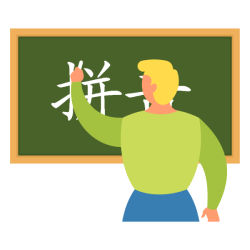
In what situation that the tones are needed to be changed?
The 4 tone changing rules
Tone Changing Rules
Remember, when we write the Pinyin for these words, we should write the original Pinyin and but the changed tone Pinyin. We write it out here is just for your reference.
Case 1: 一 (yī) and 不 (bù)
|
Rule |
Pinyin |
|||
|
When the word tone after一 (yī) and 不 (bù) is 4th tone, it will be change to the 2nd tone (yí) and (bú). |
yī > yí bù > bú |
|||
|
Examples |
||||
|
一个 一切 一刻 不要 不在 |
One Everything A moment No Not here |
yī gè > yí gè yī qiè > yí qiè yī kè > yí kè bù yào > bú yào bù zài > bú zài |
||
Case 2: 一 (yī)
|
Rule |
Pinyin |
|||
|
When the word tone after 一 (yī) is 1st, 2nd, and 3rd tone, it will be change to the 4th tone (yì). |
yī > yì |
|||
|
Examples |
||||
|
一根 一瓶 一碗 |
A strand A bottle A bowl |
yī gēn > yì gēn yī píng > yì píng yī wǎn > yì wǎn |
||
Case 3: Overlapped Words
|
Rule |
Pinyin |
|||
|
When there is overlapped words/ repeated characters in one word, the second word’s tone will be change to neutral tone. |
mā mā > mā ma |
|||
|
Examples |
||||
|
哥哥 奶奶 叔叔 |
Elder brother Grandmother Uncle |
gē gē > gē ge nǎi nǎi > nǎi nai shū shū > shū shu |
||
Case 4: 3rd tone + 3rd tone
|
Rule |
Pinyin |
|||
|
When the word is combined with both 3rd tone characters, the first one will be change to 2nd tone. |
nǐ hǎo > ní hǎo |
|||
|
Examples |
||||
|
老板 水果 手指 |
Boss Fruit Finger |
lǎo bǎn > láo bǎn shuǐ guǒ > shuí guǒ shǒu zhǐ > shóu zhǐ |
||